2024 Conference Edition!!











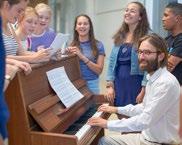
Share your passion for music with others.
Positively impact students' lives. Fill music education positions available nationwide.
Expand musical experiences in schools.
Advocate for the arts in your community.
“ “ “ “
The best part about being a music teacher is you get to go back the next day and do more and better for your students.”
— Dr. Alice M. Hammel, Instructor Music Education, James Madison University
The next generation of young people needs to understand that no matter where they are, they can always set their sights on a career as an educator.”
—Veronica Jackson, Orchestra Director Alexandria High School, Adjunct Professor George Mason University
“You should consider a career in music education because it is an unabashed love of one of the most moving and expressive art forms that exists paired with the incredible and unique opportunity to shape and touch the future.”
— Jared L. Cassedy, M.Ed. K-12 Performing Arts Coordinator LHS Wind Ensemble Director Lexington Public Schools
There is no joy like seeing a child love music! Anyone can sing or play an instrument, but a child who has fun and feels safe in the music classroom carries that with them for the rest of their lives.”
—Claire Jones, Music Education Major Christopher Newport University
My goal as a music educator is to instill a love of learning and music in my students. Through music education, I hope to help students connect with each other and themselves, as well as have a way to express themselves and be creative in a positive way.”
—Kaitlyn Purcell Music Education and Performance Major University of Louisville




President Andy Forster president@mainemea.org
President-Elect Matt Waite presidentelect@mainemea.org
Past-President Sandy Barry pastpresident@mainemea.org
Executive Director Beth LaBrie execdirector@mainemea.org
Secretary Cassie Cooper
Treasurer Sarah Bailey
G. Music PK-5 VP Caitlin Geishaker
G. Music 6-12 VP Kayla Peard
Orchestra VP Andria Bacon
Band VP Sarah Dow
Choral VP Dr. Christian Giddings
Jazz VP George Redman
D1 Chair Eric Halpin-Desmarais
D2 Chair Erika Batalla Gates
D3 Chair Brandon Duras
MMEA Executive Director Office Hours:
Beth LaBrie will be providing Office Hours each week when she will be readily available by phone or email:
Email: execdirector@mainemea.org
Phone: 207-754-5426
Hours: Monday 8:00-10:00 a.m. & Wednesday 11:00-1:00 p.m. Evening appointments during the week are also available.
Every effort will be made to reply to communications within 24 hours of weekly business hours (Mon–Fri).
D4 Chair Kris Vigue
D5 Chair Danielle Collins
D6 Chair Jamie Calandro
D7 Chair Jon Simonoff
DEIA Nathaniel Menifield
Music Teacher Education Dr. Philip Edelman
Tri-M Honors Society Jen Fortin
Advocacy Heidi Corliss
Retired Teachers Nora Krainis
MMEA Historian Sam Moore-Young
Teacher Mentor Erin Morrison
Collegiate Advisory Council Dr. Rebecca Dewan
MIOSM Savannah Wright
Webmaster Adam Metzler
Editor Hanna Flewelling
Social Media Hanna Flewelling
Conference Bill Buzza
Conference Registrar Jon Simonoff
Jazz Conference Assistant Aaron Henry
BOC All-State Festival Kristen Thomas
Jazz All-State Festival Kristen Thomas
All-State Auditions David Morris
Instrumental Jazz Jason Priest
Vocal Jazz OPEN
Solo & Ensemble OPEN
BOC All-State SSAA Chorus Julia Edwards
BOC All-State SATB Chorus Ashley Albert
BOC All-State Orchestra Ben David Richmond
BOC All-State Band Kyle Smith
Jazz All-State Honors Jazz Kayla Peard
Jazz All-State Jazz Band Craig Ouellette
Jazz All-State Combo Jason Priest
Jazz All-State SSAA Chorus David Morris & Jesse Meyers-Wakeman
Jazz All-State SATB Chorus Ciara Hargrove
The official publication of the
Maine Music Educators Association
Maine Music Educators Association (MMEA)


280+ members including working music educators, retired teachers, and collegiate students Formally founded in 1917, MMEA is the oldest recognized state music educator association in the USA.
Mission Statement: Mission: To advance, advocate for, and expand access to music education in Maine.
Vision: Advancing music education for all.
All editorial materials should be sent to:
Hanna Flewelling, Editor Email: editor@mainemea.org
All advertising information and orders should be sent to:
Beth Labrie, Executive Director
Email: execdirector@mainemea.org
AS I APPROACH the last few months of my presidency, I am reminded of how lucky I have been to be able to work alongside so many wonderful educators in this state. I have learned so much during a short period of time. Now, if I could only control the weather, that would be something great! Thank you all for inspiring me and thank you for creating an atmosphere where students can thrive. Thank you for sharing the gift of music, making the world a better place one note at a time. We are NAfME!
Over the span of my career, I have come to realize that rhythm is an aural skill. Have you ever wondered why some students have a strong aptitude for rhythm and other students are seemingly arhythmic? Aside from correlations with language and mathematical skill, sometimes you can run across a student who is academically strong across all content areas but seemingly cannot grasp even the simplest rhythmic concepts. Let me share with you a success story that outlines this premise that rhythm is an aural skill.
My student (I’ll refer to him as Schroeder) arrived into my ensemble his freshman year as a below average woodwind player. Schroeder was actually a decent player if near other students playing the same part. If at any point I asked Schroeder to play alone during a lesson, it was apparent that rhythm was not his forte. In fact, he was literally not capable of playing four quarter-notes in a row with a steady beat. I made the assumption that his rhythmic deficiencies would work themselves out as the
year progressed. Unfortunately, there was no advancement in his rhythmic skill. I decided at this point that I would make Schroeder be my project for the following year. I was determined to turn him into a strong rhythmic player.
Here are the steps (and mistakes) I took to lead him to success.
Step 1: I asked Schroeder to play one quarter-note each time the metronome got to beat one in 4/4 time. I used the Tonal Energy Tuner app with beat one set to be the higher pitched and accented beat. I thought this would be a simple skill that would give him confidence so that I could move onto other things. This first step was a huge failure. He only played a single quarter note on beat one about 10% of the time and that was mostly by accident and not due to his skill. It was time to back up a step.
Step ½: I eliminated the instrument and asked Schroeder to clap or tap a toe each time the metronome got to beat one in 4/4 time. Surely this would be the correct

starting point for his journey toward rhythmic expertise. Unfortunately, this step was also a huge failure. His accuracy rate was still about 10%. It was time to take another step back.
Step ⅓: I eliminated large motor movements and focused on tapping with a single finger each time the metronome sounded the higher pitch on beat one. After about five minutes, Schroder had a 90+% success rate.
Schroeder obviously had a slow reaction time with his motor skills but that was not the primary obstacle preventing him from rhythmic success as he still could not play four even notes in a row with

When: June 10 – 12
Where: Washington, DC Area
The 2024 Collegiate Leadership Advocacy Summit (CLAS) is a multi-day event with leadership-centric learning sessions, advocacy training, and numerous professional networking opportunities. This year’s Summit will provide NAfME Collegiate members from across the nation the opportunity to network with the profession’s top leaders during NAfME’s National Leadership Assembly. Space is limited to 100 attendees.
For complete information—including registration details, funding resources, blog posts, and more—visit the 2024 CLAS webpage.


or without a metronome. We had even eliminated any motor skill involving limbs and just tried to say a syllable on beat one. Even limiting him to vocalizing resulted in about a 10% success rate.
What made the difference in Schroeder becoming 90+ % accurate with tapping on beat one? Things turned around drastically in his success when we focused on listening to the empty spaces between the clicks and understanding it was just as important as the clicks.
What happened next?
Once he became aware of listening to the space, he quickly developed enough skill to be accurate nearly 100% of the time across multiple tempi. I figured at that time, we could start to divide the beat into two even taps on beat one. That logical progression proved to be chal lenging since the first 30 attempts resulted in uneven notes that would have challenged any quantization al gorithm in Sibelius or Finale. However, as soon as we focused on listening to the space between the notes and making sure each space was equal, things really started to improve.
click or count, long duration notes became easier by relying on his internal counting that had been matching the metronome. Removing the metronome required him to lean on his internal voice for counting, which is an aural skill.
This whole process took a semester and he quadrupled his ability in a matter of weeks. Schroeder set clear goals and I provided the information of how we would progress. He had the goal of being rhythmically confident and not relying on the students around him to get him through the music. I emphasized the process was going to be slow and rudimentary. Patience was key. Yes, there were times when I felt like Richard Dreyfuss in Mr. Holland’s and wanted to resort to using a football helmet and large bass drum beater to beat the time into my student. I had to remind myself to measure any success, no matter how small, as something to celebrate.

There were many more steps along the way. The nice thing about the Tonal Energy app is that the metronome can be set for human counting, which aids students in internalizing their own voice for counting. Eventually, we moved on to being able to tap and play on any beat in the measure and then any eighth-note in the measure. Like many students, Schroeder was challenged by notes of long duration. However, with the aural aspect of listening to a metronome
In the end, Schroeder became a strong player who was on par with his peers and someone who had the confidence to independently play his parts. The key to his success was learning to view rhythm as an aural timepiece requiring him to view silence as a measurement. I hope that you will find something in this personal journey that will help one of your students. I leave you with one last tidbit of advice: teach quarter-note triplets as FOUR evenly-spaced rhythmic events and not three (the three notes of the triplet plus whatever happens next). Think about it. That tidbit has been a game-changer for my students.
Thank you for listening, -Andy
IAM FILLED with anticipation for our All-State Professional Development Conference this year! I am looking forward to connecting with colleges and the sessions we have this year. I will highlight some of the presenters and session topics I am the most excited about for our upcoming 2024 conference.
One of the recurring themes I’ve discovered from talking with folks in the choral world is the constant need for inspiration to create exciting, accessible, and affordable programs. As choral folks, we sift through hundreds of pieces a year to find the best ones that fit our ensembles. Therefore,
by Dr. Christian Giddings

one of my main focuses this year at All-State is a series of repertoire sessions with music aimed at the public domain so that it is free for folks to use year after year. We will have several reading sessions of various public domain gems for DEIA-focused music, treble choir, SATB high school, and vocal music for PreK-5. Since the music will be public domain, folks will have a large set of resource packets to bring home to their schools to work with. I hope that people who attend the choral sessions will have a lot of resources that are affordable and inspiring to program with your choirs the following year!
In addition to the repertoire sessions, I am extremely excited to welcome composer Greg Gilpin to Maine All-State this year for a number of sessions on warm-ups, repertoire, and text stress at our conference. If you don’t know Greg Gilpin’s works, they are lovely and accessible, and he writes well for all ages of choir. We are super excited to welcome him to the conference this year, so make sure you attend! I hope that you will find these presentations engaging, relevant, and practical! I look forward to your thoughts, and feedback, and connecting with you all this spring. All the best, and see you soon! n

The Westin Peachtree Plaza, Atlanta, Georgia September 25–28, 2024
Join us in Atlanta this year!
The Executive Committees of NAfME’s Society for Research in Music Education and Society for Music Teacher Education have an open call for research proposals for the 2024 Biennial Conference, starting January 8, 2024, through February 12, 2024.
For proposal submission and registration information, visit: bit.ly/2024MRTE

By Isaac D. Hawkins and Drew X Coles
AS MUSIC EDUCATORS, we begin forming our identities long before the start of our teaching careers because they are tied so closely to our larger music identities. Each identity is influenced by our upbringing and our experiences as students of music (Mockler, 2011). In our experience, one’s identity as a band director can begin to develop from any musical experiences that also involves leadership—perhaps seeing one’s older siblings perform in the high school marching band while in a younger grade, or being introduced to music as a component of church or worship events. An even earlier influence could be from the type of music one listens to as a child. We take all of the aspects of our larger music identity and use them as important, but not all encompassing, parts of our music teacher identities. Our teaching environment, the larger systems at play, and our continuing professional development continually shape our music teacher identities.
When considering our identities, the words with which we describe ourselves matter. As a practicing music educator, consider your job title in your email signature. For the first year of teaching at Gorham High School, Isaac Hawin’s email signature told everyone he communicated with that he was the director of instrumental music. A year later, in the same job Hawkin’s email signature tells people that he is an instrumental music teacher at the school. His job responsibilities didn’t change, but the way he thought about his job did.
In many ways, the role of music educators skirts the line between director and teacher. We manage libraries of sheet music and inventories of expensive musical resources. We develop and manage complicated budgets that impact large groups of students with extremely specialized materials. There are so many moving parts to our programs that our jobs may feel different from the jobs
of many other teachers, and we should feel empowered to recognize the work that we put in. These administrative aspects may make us feel as though we are directors and not teachers. This is a concept that we feel mirrors itself within higher education, particularly in institutions where faculty carry administrative loads.
Teachers should take care to see how our identities affect our actions in the classroom. When we call ourselves directors, what types of images are brought to our minds or the minds of our students? Is this different when we call ourselves teachers?
Mockler (2011) goes so far as to say that our identities as teachers influence the ways in which we make pedagogical, curricular and assessment decisions. Thus we can infer that a teacher who envisions themself as a teacher and facilitator will make choices that honor student voice and contributions more often than a director. On a more hopeful note, Mockler adds that teacher identity is fluid and
When I imagine directing a band, I think of my interpretation. I think of what I want the band to sound like. In fewer words, I am at the center of my interactions with students. When I imagine myself as a teacher, I imagine myself helping students to learn their instruments and fostering a love of music and the community of musicians around them. I see myself facilitating the development of their interpretation of a composer’s intent through research and performance. In the vision where I am a teacher, my students are more centered in my instruction.
When I imagine my role as director of an academic program at a higher education institution, I tend to group student interests and outcomes together, sometimes missing the nuance of the individualized experience that our institution can give. When I think of my role as a teacher of a particular course, I am much more focused on a constructivist pedagogically enriching, student-centered experience, from which I can also learn. Grappling with these two identity-roles can often feel like zooming in and zooming out very quickly while using a camera. However, I too find myself wanting my practice to ideologically align with that which I would describe as the ways of a teacher/facilitator.
constantly changing, so even if you identify yourself as a director, that does not mean it cannot change. In addition, identity can be fluid from context to context, where an educator may function as a director in one context and a facilitator or teacher in another.
Hoffman and Carter (2013) studied student experiences in a composition based secondary school music curriculum. They found that students described directors and teachers differently. Teachers were facilitators who listened to students, took their interests into account, and allowed students to interact in class. Directors forced their own interpretation onto students and controlled all aspects of the student experience. Reeve (2009) cites two types of classroom structures teachers use. First, a controlling/motivating
“The process of preparing music educators to meet the needs of a nation with rich diverse needs, cultures, and resources embodies the challenges colleges and universities must recognize to improve candidate readiness to enter and thrive in any community.”
—A Blueprint for Strengthening the Music Teacher Profession, June 2023

NAfME formed the Music Teacher Profession Initiative in 2021 to identify barriers to equity in music teacher recruitment, education, and retention. A task force of NAfME leaders representing institutions of higher education across the country conducted research related to the challenges facing high school students as they make the decision to pursue a career in music education, preservice music educators in their undergraduate degree programs, and novice music educators in their first five years in the profession.
Read the report: bit.ly/NAfMEMTPI
classroom forces students to adopt a teacher's perspective and pressures students to feel in particular ways. Second, autonomy supportive structures allow students to have their perspectives be adopted and recognize their feelings. Together, the research of Reeve (2009) and Hoffman and Carter (2013) show a connection between a controlling motivating classroom structure and directors. Teachers, on the other hand, were more supportive of student autonomy. The perspectives of students show that educators who take on the role of teacher and create autonomy supportive environments help students to feel more heard and successful in the classroom.
The words with which we describe ourselves matter
Ultimately, the words we use to describe ourselves as educators are not merely labels but representations of our values, beliefs, and aspirations. By thoughtfully selecting and embodying these titles, we reaffirm our dedication to the transformative power of education and our role in shaping the minds and futures of the next generation. If our intent is to teach, then we should call ourselves teachers. If our intent is to direct, then we should call ourselves directors. Both titles acknowledge aspects of the work we do, but we should be sure that our titles, and how we use them, reflect the quality relationships and positive classroom environments that we foster every day. n
References:
Hoffman, A.R., & Carter, B. A. (2013). Representin’ and disrespectin’: African-American wind band students’ meanings of a composition-based secondary music curriculum and classroom power structures. Music Education Research, 15(2), 135–150. https://doi.org/10.1080 /14613808.2012.685458
Mockler, N. (2011). Beyond “what works”: understanding teacher identity as a practical and political tool. Teachers and Teaching, Theory and Practice, 17(5), 517–528. https://doi.or g/10.1080/13540602.2011.602059
Reeve, J. (2009). Why Teachers Adopt a Controlling Motivating Style Toward Students and How They Can Become More Autonomy Supportive. Educational Psychologist, 44(3), 159–175. https://doi. org/10.1080/00461520903028990

Conversational Solfege
s ocial e M
The 12-step Conversational Solfege curriculum is a unique pedagogical approach for teaching music literacy to 2nd through 8th grade students. With this approach, music literacy starts with great literature and an “ear-before-eye” philosophy that correlates with the Core National Standards for Music Education. Great songs are broken down into their basic components and then reassembled so students can apply greater musical understanding.
Level 1:
U p B eat !
Just as a conductor’s preparatory “upbeat” gesture at the beginning of a performance influences the way an ensemble plays, we too get to choose our “upbeat”—our thoughts and attitudes—at the start of each day, at the beginning of each class, and in our interactions with students and colleagues.
Mindset, Mindfulness, and Leadership in Music Education and Beyond
Matthew Arau
With this clever premise at its core, Upbeat! presents a winning combination of mindset and mindfulness strategies as well as leadership principles that will motivate, inspire, and transform not only your internal world but the culture of your music program.
S. McConkey N. Edgar
G-5380FL
Foreword by Tim
Lautzenheiser
Divided into three parts—Ignite, Inspire, and Lead—Upbeat! takes readers on a journey from internal self-reflection to outward expressions of leadership, with chapters addressing such topics as:
• Self-care for optimal mental, emotional, and physical wellness
G-5380 Teacher’s Manual $48 95
• The transformative power of positivity and gratitude
• Growth mindset
practical guide takes teachers through 13 sequential designed to hone important self-care and SEL skills, regulation emotions, resolving conflict, managand building positive relationships. Each unit around the 3 core pillars of SEL—IdentiBelonging, and Agency—and offers connections for pre-service and in-service music teachers that guide through a series of thought-provoking exercises to their skills, as well as space to discover, reflect, draw, and commit to growth.
Level 2:
• Mindful breathing and listening in an ensemble setting
• Fostering a culture of excellence and connection
• Creating vision and mission statements for your organization
• The essential qualities of an effective leader
• How to develop a thriving student leadership program
G-5381 Teacher’s Manual $49 95
G-5381FL Flashcards 79 95

Dr. Matthew Arau, founder of Upbeat Global and Upbeat! Leadership Workshops, Coaching, and Keynotes, is an Associate Professor of Music and the Chair of the Music Education Department and the Symphonic Band Conductor at the Lawrence University Conservatory of Music in Appleton, Wisconsin.
Upbeat! presents a winning combination of mindset and mindfulness strategies as well as leadership principles that will motivate, inspire, and transform not only your internal world but the culture of your music program. Divided into 3 parts—Ignite, Inspire, and Lead—this thought-provoking resource takes readers on a journey from internal self-reflection to outward expressions of leadership. With immediately applicable ideas and strategies that work for students, teachers, and professionals in any field, Upbeat! affirms the importance of living and working with intentionality and establishes that what we do, why we do it, and how we do it matters.
95
With immediately applicable ideas and strategies that work for students, teachers, and professionals in any field, Upbeat! affirms the importance of living and working with intentionality and establishes that what we do, why we do it, and how we do it matters.
G-10550
Level 3:
(Each CD is also available as an MP3 download.)
Conversational Solfege Explained DVD
Edited by Scott N. Edgar
John Feierabend presents 6 hours of instruction on the history, philosophy, and pedagogy of Conversational Solfege and demonstrates the many fun and effective techniques for teaching all 12 steps in each of the 13 units.


DVD-946 2-DVD Set . . . . . . . . $34 95 (Also available as a streaming video.)
M U sic e d U cation and otional earning
Scott N. Edgar

This pioneering book addresses how music educators can utilize Social Emotional Learning (SEL) to maximize learning in the choral, instrumental, and general music classroom at all levels, and at the same time support the students’ social and emotional growth.



By Benjamin Cox
THE MIDCOAST SUMMER Wind Ensemble (MSWE), now in its third season, is a non-auditioned ensemble that is open to high school students and community members. MSWE’s mission is to provide a place for people to make music throughout the summer months, with a focus on performing high quality wind band literature from a variety of time periods and composers. MSWE is led by conductors Benjamin Cox of Mt. Ararat High School and Brandon Duras of Brunswick High School. One of the best things about MSWE is that there is something for everyone. For our students that participate they get to perform cornerstones of the wind band repertoire while getting a chance to play alongside more experienced community musicians. For our community members, they get a chance to play new wind band literature and corner-
stones of the repertoire in a low pressure environment.
This year we will have our first rehearsal on June 16th. We rehearse every Wednesday from 6:30pm-8:00pm in the band room at Mt. Ararat High School (Topsham, ME) until our end of season concert which will be August 14th in the Mt. Ararat High School Forum. MSWE is completely free to join and we welcome all ability levels, we have a number of experienced teachers and performers in the group all who are happy to share their expertise. If you are interested in joining please fill out the linked form so we can add you to our contact list or if you have any questions please reach out directly to Benjamin Cox at coxb@ link75.org.
Midcoast Summer Wind Ensemble Sign Up 2024.
Please share with anyone you think may be interested, we hope to see you this summer! n


“The process of preparing music educators to meet the needs of a nation with rich diverse needs, cultures, and resources embodies the challenges colleges and universities must recognize to improve candidate readiness to enter and thrive in any community.”
A Blueprint for Strengthening the Music Teacher Profession, June 2023
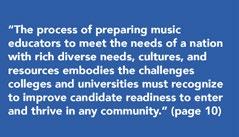
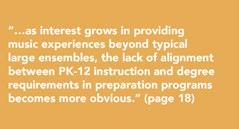




On the NAfME Grassroots Action Center page, you can:
• Support music education in federal education policy
• Get involved with the legislative process
• Engage your members of Congress
NAfME Public Policy staff regularly provide updates to the education funding process and legislation that directly impacts music education funding and access. On this page you can find ready-to-send letters that you can customize and submit to your members of Congress to take action on issues that affect music education.
Go to bit.ly/NAfMEgrassroots (case-sensitive) and take action today.

By John Neal
THE BEST COMPASS you can have, the best anchor you can own when the sailing gets choppy, is a philosophy of music education.
Your philosophy is your why. Why am I doing this work? Why is it important? Why does it deserve the funding it’s receiving? Why am teaching this music, as opposed to that music? Why do I grade the way I grade? Why is it important that I demand that kids partici pate in this concert/fes tival/audition?
If you direct an ensemble, then the music you choose is your curriculum.
I could write a whole article on programming (and maybe I will someday!), but are you really serving your kids if you program only what’s on the top-40 charts? Or only program “classical” music, for that matter? And what happens
when a parent questions why you programmed “that” piece? Do you have an answer, beyond “I liked it”? If you have worked out a personal philosophy of music education, then you will always have a good answer.
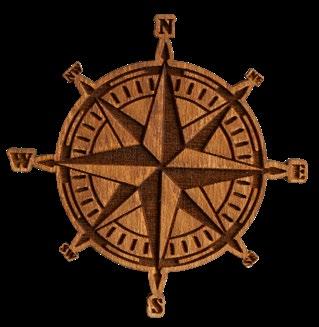
It may be that your undergraduate preparation addressed this question. If it did not, I can point you to the classic works on the subject: Bennett Reimer’s “A Philosophy of Music Education” and (if you want to expand your vocabulary!), Suzanne Langer’s “Philosophy In A New Key.” I would also be happy to share my philosophy with you, if you think it would be helpful. I would only caution you that your philosophy should be based in
the music itself, not on some extra-musical construct (like “being part of a positive group”).
The music should be its own justification, otherwise whatever the kids are getting out of it could be obtained in some other way.
You might be persuaded that a philosophy is a fuzzy thing, nice to have maybe, or maybe something that the college music professors could use but would be of no real benefit to you—but I couldn’t disagree more. Your philosophy will form your blueprint for what your program will be. Sure, there are the Maine Learning Results and the National Standards for Music Education—

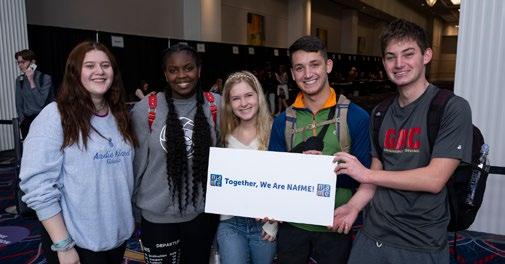


IAM SO EXCITED for the MMEA
All State Conference this year! It is always a great time to connect with colleagues, meet new ones, and have a chance to recharge before the busy end of the school year. For the General Music 6-12 areas this year, I have collected a wide variety of sessions ranging from DEIA, Advocacy, Modern Band, Electronic Music, and Self Care. Below I have highlighted some of the sessions that I am most looking forward to!
Dr. John Ginocchio, Director of Bands and Professor of Music at Southwest Minnesota State University, will be presenting a session called “Planning and Teaching a Popular Music Performance Class.” We all have students in our schools who may love music, but band and choir aren’t for them. Dr. Ginocchio’s session will focus on “how popular music performance classes can provide guided education experience for many of those students while expanding learning opportunities in music for all students.” During the session, he will present ideas for teachers on how to organize and run this type of course.
In the post-COVID world, creating budgets can be a difficult situation in most school districts with music and the arts often being the first thing thought of to cut. This is where you as the music teacher can help advocate for your program. Heidi Corliss has many ideas for us in her session “Advocacy: Saving and Protecting Your Program from Day 1.” She will have tips and tricks that we can use to help educate our administrators and community members so our program can be supported. She will also discuss what is happening around our state and at the national level.
As we head into the end of the year, it can often be overwhelming and draining with the number of concerts and events we participate in. Summer is close, but not quite there. You could even be feeling the edges of burnout. Dr. Timothy Heath who is the Director of Bands and Assistant Teaching Professor of Music at Wake Forest University in Winston-Salem, North Carolina, has a session that will help you reignite your passion for music along with having ideas to create and maintain a healthy work-life balance. You will leave with strategies that you can work on implementing right away.
While that is only three of the amazing sessions that we have planned for this year, there is definitely something for everyone.
I encourage you to come and join us at the MMEA Conference and at these sessions. It will be a great way to connect with your colleagues and learn something new! I hope to see you there! n


AMPLIFY IS AN EXCLUSIVE ONLINE SOCIAL NETWORK JUST FOR NAfME MEMBERS.
• Discuss and Share – Younger educators can find ideas and share what they have learned. Experienced educators can mentor colleagues new to the profession. Plus, download resources relevant to your career—all in one platform.
• Network with Educators – Wherever you are, you can reach out to colleagues in other states and countries. Search a directory of your fellow 60,000 members.
• Go to community.nafme.org.
• Edit your profile using your NAfME.org member username and personal password.
• Control what is visible on your profile.
• Join/subscribe to communities of your choice – you will automatically be enrolled in Music Educator Central.
• Control the frequency and format of email notifications from Amplify.
Visit Amplify’s FAQ section: bit.ly/AmplifyFAQ (case-sensitive).
Reach Member Services at: 800-336-3768 or memberservices@nafme.org.
Bookmark Amplify on your browser: community.nafme.org.
By Brandon Duras
THIS SUMMER I’m excited to be traveling to Gwangju-Gyeonggi, South Korea to present at my first international conference at the World Association of Symphonic Bands and Ensembles (WASBE). WASBE is the only international organization of wind band conductors, composers, performers, publishers, teachers, instrument makers and friends of wind music. It is a unique organization completely dedicated to enhancing the quality of the wind band throughout the world and exposing its members to new worlds of repertoire, musical culture, people and places. The organization has welcomed a membership of over 1,000 people from more than fifty countries
For those of you who do not know, WASBE was co-founded by Frank Battisti, longtime Director of Bands at New England Conservatory. WASBE began as an idea to bring together an international representation of wind band professionals to share ideas and discuss problems and opportunities. Alongside William Johnson and Timothy Reynish, Battisti achieved his goal to support the wind band movement. WASBE’s first biennial conference was held in 1983 in Skien, Norway. I submitted my session when WASBE put out their call for sessions sort of on a whim. What made me think I had a chance was their specific mention for sessions targeted towards school ensembles. Even if I did not get picked, who
cares! A few months later, much to my surprise they had accepted my session: “Now it’s starting to sound like music: rehearsal techniques for a high school classroom.” The session idea came to me from an article I wrote for the Yamaha Educator Suite titled “8 Unconventional Rehearsal Tips.” This was my first article with Yamaha, and honestly I just wrote what I knew hoping someone, somewhere would take anything from it. With the enthusiasm from Yamaha, I thought maybe there was something there.
“Now it’s starting to sound like music” is a phrase I use when my students go from playing pitches and rhythms to making music. Music has purpose and meaning that can take a while to get to the core of it. Often in rehearsal we get hung up on things that leave less time for the more expressive qualities. In this session I will share rehearsal techniques that I use in my classroom to bring the students to the next level of musicality from the beginning of the rehearsal process instead of the end.

an understatement. I’m not only filled with nerves, but also with excitement to be able to take this opportunity to share what I do with others from around the world. Not to mention I get to see and meet some of the “celebrities” of the band world! I’m also lucky to not have to do this all alone as I will be there with some familiar faces including Dr. Will Kinne from the University of Southern Maine, and his predecessor Dr. Trae Blanco, both of whom will also be presenting! I would like to take a moment to thank MMEA for giving me the opportunity over the past few years to invite me to present at the All State Conference. 2021 was my first presentation, and I’m not looking back now. If I can instill any advice to those who have made it this far: don’t be afraid to take chances and reach for what seems out of reach. This New Hampshire-native, young band director from the state of Maine is hopefully all the proof you need to know nothing is out of reach.
This will be my first (and hopefully not last) international presentation and trip to the Asian continent. To say I’m nervous would be
If you would like to help support my trip to Korea, please consider donating to my GoFundMe page to help pay for airfare, hotel, and conference cost. n
By Michael Remy
MAINE HAS A LONG history of leading the way on a variety of national issues, so it was no surprise when I recently discovered that 96.1% of Maine high schools offered at least one non-traditional music class. These are classes other than band, orchestra, chorus, jazz, music theory, and musical theater. While traditional courses have rich histories and the potential to offer high-level musical experiences to many students, they aren’t for everybody, and some students opt out.
Traditional music education has remained relatively unchanged since the mid-20th century. Researchers who have investigated the demographic trends of American music education have found that roughly only 20-30% of students participate in high school music (Elpus & Abril, 2011). Additionally, such trends have revealed that participants are overwhelmingly White and of higher socioeconomic status (Elpus & Abril, 2011; Kinney, 2018; Stewart, 1991). Non-enrolled students claim that traditional offerings fail to reflect their social and cultural identities, leaving them to feel unrepresented (Clauhs & Cremata, 2020). While non-traditional music classes have the potential to offer experiences to all students in ways that traditional courses cannot, they aren’t for everybody, and some teachers opt out.
From 2013-2023, I taught at Mount
Desert Island High School (MDIHS), which offered both robust traditional and non-traditional music classes. These included band, orchestra, chorus, jazz, show choir, guitar, popular music ensemble, A.P. theory, music technology, and music explorations. We occasionally offered songwriting and music listening clubs and held informal, student-led concert series throughout many school years. These offerings were the result of incredible support from the administration, community, and of course, the students. While cynics often express concerns that these courses might detract from traditional programming, this is the opposite of our experience at MDIHS. These courses attracted students with a love and curiosity of music who would often seek out further offerings, including traditional ones. The popularity of our non-traditional classes directly contributed to the success of our ensembles, leaving me to wonder what was happening at the national level.
In the fall of 2022, I surveyed
NAFME’s national membership to investigate the status of non-traditional music classes in the United States (Remy, 2022). I hoped to discover what kinds of classes were offered, where they were offered, and the commonalities between the places that offered them. While I found some interesting trends in teacher perceptions on non-traditional music classes, the response rate was too small to generalize about the quantity of programming. As an extension of this study, I decided to explore publicly available programs of studies on school websites beginning with the state of Maine.
I began by cross-referencing the list of public Maine high schools found on the National Center for Educational Statistics website with a county-by-county review of schools on Wikipedia, finding 131 public high schools to include in the search. Of those, 103 (78.6%) schools had programs of studies listed on their school websites. It is worth mentioning that schools in less populated counties were less likely to have programs of studies
listed online. Nevertheless, I found that 99 schools (96.1%) offered at least one non-traditional music class, far surpassing the 57.1% national average discovered in my 2022 survey.
Though I was most interested in non-traditional, I documented all music courses.
Most Maine schools offered band (91%) and chorus (91%), but orchestra was only offered at 18.2% of schools. Music theory was found in 57.6% of schools, with 36.8% of these offered as Advanced Placement courses. The most popular non-traditional offerings were guitar (59.6%), piano (54.5%), and music technology (33.3%), mirroring the most popular classes found in my 2022 national survey.
courses don’t fall under the same umbrella. For this study, music history was lecture-based, often on American popular music (40.6%) or the history of rock and roll (40.6%). Music appreciation tended to also be lecture-based, but covered a variety of topics like theory, history, and listening, whereas music explorations typically added an element of hands-on engagement. There were
sound and stage design, often corresponding with musicals or plays. In the case of guitar, piano, theory, music technology, and songwriting, many schools offered tiered courses, but this was not accounted for in the data.
WNon-performance courses like music history (32.3%), music explorations (17.2%), and music appreciation (13.1%) combined were found in 62.6% of schools, but these
several unique ways that Maine high schools structured programming. For instance, 12.1% of schools offered introductory band, providing an entry point for beginners. It would be interesting to examine if these courses were a reaction to declining enrollment due to COVID-19 or part of a tradition of inclusivity. Some schools paired music technology with music theater, including elements of
hile 96.1% of Maine schools offered some form of music programming beyond traditional ensembles, this study was not able to investigate if these courses increased participation. Maine appears to be a model for alternative music programming, but there are likely still students who remain disengaged. Music teachers must continually adapt to meet the evolving needs of their schools and communities. Fortunately, 96.1% is a number worth celebrating, suggesting that the doors remain open for additional classes or at very least, resources might be closer than you’d think. This is good news for Maine students who might be looking for a variety of ways to engage with music. Indeed, the way life should be. n



May 16 & 17

Join us at the 2024 MMEA All-State Conference! 50+ conference sessions over 2 days at the beautiful University of Maine at Orono!

• Choral reading sessions for every grade level
• Orchestra reading session
• Brass Teaching Techniques
• Sessions on supporting LGBTQ+ students
• Sessions about Modern Band
• Sessions on Jazz Improvisation
• Meet NAfME Eastern Division President Michael Brownell
• Network with music industry vendors
15 Professional Contact Hours / 1.5 CEUs


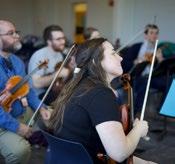


Dr. Timothy Heath
Leadership in ensembles starts with the conductor-teacher. Effective leaders continuously grow as musicians and teachers while providing the best instruction possible to their students. This session has four areas of discussion. First, the clinicians will guide the audience to a stronger understanding of leadership and impact. Second, they will share how to provide appropriate positive feedback to your ensembles. Third, they will provide ways to continue to grow as a musician and educator after completing your degrees. Finally, they will discuss the importance of a work-life balance and how it can benefit everyone to be the version of themselves.
Brandon
Duras & Evelyn Prince
Social media consumes our lives. Students especially spend an increasing amount of time on social media. Instead of fighting against
it, why don’t we embrace it and use it to our advantage? Feeling like you might be too old to connect with students in an effective way? No worries! Brandon Duras (old-man music teacher), alongside his student Evvie (in-tune youth) have worked for four years developing a booming social media presence. In this session, they will provide tips and tricks on how to use social media to build your brand for your music program in an engaging and exciting way.
Bronwyn Kortge
Do you want more insight into how to prepare the classical all-state vocal audition? We’ll break down next year’s specific audition components: the aria, the madrigal and the scale. We’ll look at the MMEA website tools available to help prepare. We’ll introduce fundamental vocal technique as we dig deeper into the aria and the madrigal, exploring basic Italian pronunciation and essential stylistic demands of the aria. We’ll share techniques to teach these concepts, as we learn the song. We will explore the madrigal’s pronunciation, phrasing and stylistic demands.
David Stern & Erica Scarano
Interactive session! Please bring your tubas and/or mouthpieces. We will discuss innovative ways to cultivate young tubists. Regardless of size, you can play tuba! Topics will include suggested equipment and potential financial resources to support your situation.
Chris Plaisted
Mr. Fix-Its guide to basic instrument maintenance, specifically focused on the common stressors
for Maine instruments. About 80% of common school band instrument repair problems can be avoided with proper maintenance. We will discuss techniques, tools, and products to help you and your students properly maintain woodwind and brass instruments.
Ben Potvin
If we want band students to make an informed decision about the instrument they want to play, they need to try it out first! This session will include an explanation and demonstration of the Jupiter mouthpiece Try-Out Kits. Conference attendees will also be invited to test the kits out for themselves. For the remainder of the session, tips and tricks will be shared to create a well organized, fun, and supportive music room where band students will want to learn. Sponsored by David French Music.
Dan Barrett
This clinic is especially for nonbrass players that teach beginning brass players (although all are welcome). This clinic demonstrates some ways to form a nice simple embouchure that can produce a beautiful sound, and how to teach this accurately without ambiguous metaphors and tricks. We’ll explore the merits of free buzzing and mouthpiece buzzing, and discuss some common embouchure problems found in young brass players. Bring a mouthpiece if you want!
WIlliam Kinne
What has been your most memorable experience as an audience member? Could you describe the atmosphere of the venue, the sounds you heard, the scent and feeling in the
air? How did the concert compare with your expectations? What made that concert experience memorable? In this session, we will explore how five unique compositions led to cross-disciplinary collaborations or multi-sensory concert experiences beyond what is expected at a wind band concert. Each participant will receive an extensive list of works of varying difficulty that lend themselves to imaginative and collaborative projects.
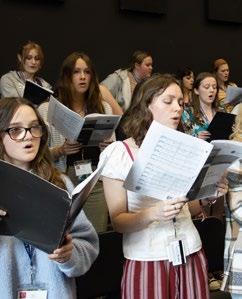
Reading Session: Public Domain Gems for Treble Choir
Cathy Murray
This reading session will explore a variety of Treble Choir literature available for free as public domain. The primary focus will be for High School level Treble Choirs but will include relevant literature for both Middle School and College levels as well.
Greg Gilpin
The first connection with a choir is
incredibly important, even magical. It creates the first communication and sets the tone for the rehearsal whether it’s the beginning of the year, the week, the day, or a one-time choral event. Greg Gilpin will present an engaging session of reminders, refreshers, and nuances involving “the meet and greet”, breath, vowel, diction, the “warm-up rut” and a list of “keeps” that will help you to connect and reconnect with your singers in every rehearsal. To top off the session, he will share favorite warm-ups from some of the most well-known choral conductors in the industry!
Greg Gilpin
Knowing and understanding selected repertoire is important to both teacher and student. A quality text sets the tone and foundation for all other vocal and interpretive teaching. The text can decide if your students will be engaged in the rehearsal. Once text is explored and understood, the teaching of how the melody and harmony connects will create a more interesting, musical experience. Through selected portions of choral works, Greg Gilpin will present ideas he uses as a composer, conductor and editor, giving tools to expand the beauty of the choral art with students.
Christine Letcher
In this workshop, participants will be introduced to the Estill Voice Model, a vocal technique model that identifies and teaches isolated control of individual anatomical structures within the voice production system. Participants will learn about a few of the key anatomical parts of the vocal tract, and will explore how to isolate and move
these parts to achieve different vocal qualities. This introductory workshop will give music teachers and conductors a few key tips that will help their students and choirs get the sound they want. Likewise, these techniques will help students and choirs achieve reduced performance anxiety and more confidence, as well as a balance of vocal health and aesthetic freedom.
James Slipp
There is insufficient research regarding how hormone replacement therapy (HRT) affects transgender vocalists, therefore music educators continue to seek further guidance to enhance this aspect of their teaching approach. This session will focus on adolescent and young adult singers with the transmasculine changing voice in the general music classroom, voice studio, and choral ensemble setting. Due to fear of vocal damage or loss of progress in vocal technique, many transgender vocalists are hesitant to pursue HRT treatment. This presentation will highlight the impacts of hormone replacement therapy and vocal techniques to encourage healthy development for transgender vocalists.
Rebecca Dewan
In this reading session, we will explore free and low cost music accessible to a wide-range of choral ensembles. Repertoire is the vehicle through which we teach our curriculum, and therefore selecting the best repertoire for the ensemble in front of you is paramount. In this session, we will utilize a DEIA lens of music education as we analyze the diversity, equity, inclusion, and accessibility of the choral curriculum, considering such elements as
composer background, accessibility of music, inclusive language, and cultural representation.
Barbershop music: It’s not straw hats and handlebar mustaches anymore!
Renae Misner
The world of Barbershop music has evolved into an exciting an invigorating genre of music. The use of more contemporary music and arrangements brings experiences for the performers and their audience. Come and see how you can easily incorporate the barbershop style into your program to enhance sight reading and ear training. We will explore some simple arrangements, tags and resources that are free to you as educators. Come and try something new!
Choral Reading Session: Galaxy Music Publishing
Drew Albert & Colin Graebert
This workshop will feature a reading session that showcases a range of choral music from Galaxy Music Publishing. The session will include songs in various voicings suitable for middle and high school choirs. Participants will have the chance
to explore new choral repertoire to inspire them for future programs. Participants will be able to sightread the reading session pieces and take home physical copies.
Reading Session: Public Domain Gems for Elementary Chorus and General Music
Christian Giddings
This reading session will explore a variety of elementary chorus and general music literature available (grades K-5) for free in the public domain.
Reading Session: Public Domain Gems for Middle School
Christian Giddings
This reading session will explore a variety of middle school (grades 6-8) literature available for free in the public domain.
Reading Session: Public Domain Gems for High School
Christian Giddings
This reading session will explore a variety of high school literature available for free in the public domain. The main focus will be on SATB voicings.

Greg Gilpin
The developing choir is a wide range of ages now where the experience has been limited or the choral art is being newly discovered. Repertoire with quality text crafted with melody and harmony for this genre of singer may be the most important tool. It sets to the tone and foundation for all other vocal and interpretive teaching. Greg Gilpin will share some of his favorite choral works for the developing choir, and how he uses them in his own rehearsals.
Greg Gilpin
Greg Gilpin will share his favorite repertoire he has conducted in his 35 plus years in the choral music industry as composer, conductor, and editor. The 2-PART music will range from openers, closers, the always difficult to find “second selection”, encores and various languages and cultures. Many selections will be available in other voicings for mixed choirs and men’s and women’s ensembles.
Gotta Sing! Gotta Dance! 2-Part Repertoire to Get Your Choir Moving
Greg Gilpin
Movement is key to learning, singing, memorization and retention, physical well-being, and inclusion. Greg Gilpin will present a selection of diverse chorals, each with its own unique movement ideas that can be incorporated into rehearsal and performance to elevate the choral art.
Caitlin Geishaker
A round table discussion to offer assistance for those of us struggling with behaviors and not enough support to make it work. Do you have magic tricks? Or failsafe activities that keep even the toughest child engaged? We know there’s not a one-size fits all solution but we can arm ourselves with many strategies that help keep the flow of the class going.
Maine Lobsters, Abby Jordan, Alicia Farmer, Johnathan Hatch, Kalina Young, Jennifer Holmes McLaughlin, Pamela Kinsey, Cassie Cooper
This group of Modern Band teachers have been active in the Music Will community and have been meeting to jam and exchange ideas on teaching practices. We have found great value in teaching through Modern Band and would like to share why and how.
Rebecca Hanaburgh & Carlena Trombley
In this session, Carlena and Becky will share activities used in their K-2 and 3-5 adaptive music classes. They will discuss location considerations, classroom set-up, materials used and ways in which speech/language and OT/PT goals can be incorporated into the classes through coordination with special ed colleagues.
Alexander Judge
In this interactive conference session, attendees will learn about and engage in content from a 10-week unit pertaining to the ragtime music of Scott Joplin that I have
created, designed, and implemented for general music students in both grades three and four. Topics discussed will include the singing of original text to “Maple Leaf Rag”, “Pineapple Rag”, “Peacherine Rag”, and “The Easy Winners”, discussion of the “jobs” of both the pianist’s left hand and right hand when performing ragtime music, and learning dance styles of the early 1900’s.
Ben Potvin
Rarely is there a trained musician who can sub for us when we are not in the classroom. And sometimes our sub plans need to be ready at a moment’s notice. During this session, electronic and non-electronic music sub plans will be presented that can be facilitated by any guest teacher. Following the presentation, conference attendees will be asked to provide their favorite music sub plans which will be compiled and shared with all session participants.
Brandon Duras & Kait ostrov
As music teachers, interdisciplinary lessons can be something we feel necessary to include in order to validate our content area. Doing this can feel forced and uncomfortable if you’re unsure of the content. You don’t have to do it alone! How thrilled would your administration be to offer a whole interdisciplinary class to your students? How thrilled would your students be to learn from the two coolest teachers in the school at the same time? In this session Brandon Duras, alongside his colleague Kait Ostrov, will share their experience developing

and teaching a fully interdisciplinary and completely co-taught class “The Physics of Music.”
Lindsey Wiehl
It’s time to welcome EDM (Electronic Dance Music) and songwriting into your music classroom. BandLab is a free online program that allows real-time collaboration of music production projects. The program’s easy-to-use interface and extensive sound library allow students to forego the writer’s block and get started on producing their own music. Come learn how BandLab can give new life to your K-12 music program, and how to lead a class in creating their own music. Explore how this program can harness student’s prior knowledge and what they already love about music and connect with your classroom objectives.
John Ginocchio
Many students in high schools have considerable interest in music, but their interests lie outside the
normal band, choir, and music appreciation courses offered in most school curricula. Popular Music Performance classes can provide a guided educational experience for many of these students while expanding learning opportunities in music for all students. This session will present ideas for organizing and running a Popular Music Performance Class.
Sue Barre
The 23/24 school marks the second year that Waterville Senior High School students have collaborated with Sara Tuttle and Erica Ball. Songs from Here gathers songs written around a given theme. This year’s theme is woods and water and the Modern Band students of Waterville High School, wrote lyrics and developed melodies and composed songs with guidance from Sara and Erica. The project culminated in a perfor-
mance at the Gordon Center for Arts at Colby College in March.
Ed Michaud
This session investigates the role of self-efficacy sources in informing the self-beliefs, teaching practices, and commitment of rural music teachers. People’s efficacy beliefs affect how much effort they will give, their resilience in the face of adversity, how they respond to stressors, and what results they realize. Understanding the four sources of self-efficacy development may motivate teachers to persist and improve their teaching practice through perseverant action, improving student learning, and strengthening commitment levels. Building connections of community are important to develop rural music teachers’ self-efficacy beliefs, and to discover an enduring concept of success in a rural teaching experience.
Heidi Corliss
Too busy for advocacy? Never! In reality, we need to advocate for our music programs and our music students everyday! We need to educate our administrators and community members so that they will support our programs. This session will give a few tips and tricks for local support as well as touching on some things that are happening at the state and national level.
Rebecca DeWan & Tammy carusone
The impact of trauma is a silent force felt in every community and every school district. Exposure to trauma–—such as violence, racism, or a pandemic—can impact students’ readiness to learn. After a brief overview of the brain science of trauma exposure, this session
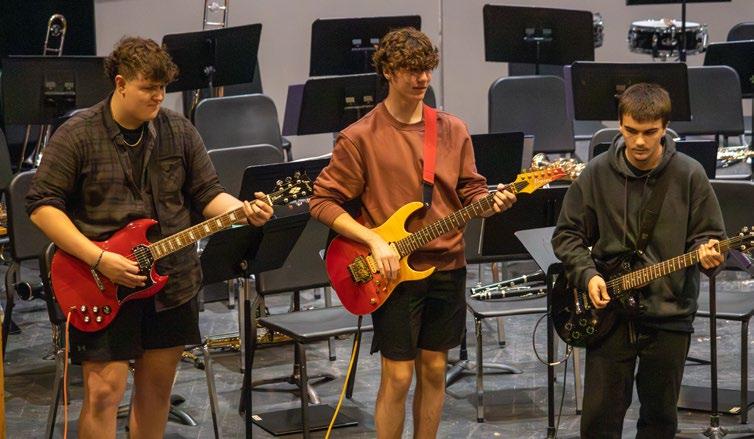
will examine teachers’ responses to student behavior through a trauma-informed lens. By exploring reactionary and preventative measures, this session provides real-world classroom strategies to make your classroom more trauma-informed.
Cassie Cooper
One safe adult can save a life, multiple safe adults can transform them. Participants will learn best practices to create safe spaces for LGBTQ+ students in music programs. Strategies will include inclusive classroom materials, pronoun and name changes, degendering language, interrupting bias, advocacy. The culminating activity will be formulating individual action plans using strategies and resources gained from the presentation. Participants will receive inclusive classroom posters, online access to SEL Activities by grade level, as well as online access to our Inclusive Schools Best Practices Guide.
Dr. Timothy Heath
At some point, we will experience burnout in our careers. It’s okay to admit you have experienced burnout or you do not have a good work-life balance. The presenter has struggled with both and will share his story and journey to recovery and reigniting his passion for music. This session provides strategies for reigniting the fire of your love of music and teaching. The session also addresses creating and maintaining a healthy work-life balance. You will leave this session with ideas on beginning your journey to finding a passion for music again and maintaining a healthy lifestyle while teaching music.
Director: John Kollman
The Hermon High School Steel Band will perform soca music from Trinidad and Tobago as well as other styles on steel pan. Come and dance (or just listen) to the infectious rhythm.
Danny Kolke & Bill Leather
Bebop by the Numbers is a super fun, simple way to learn how to improvise and create music. Breaking down the most complex concepts and using scale degrees, this method of exercises and games introduces you to Stingers, Pickups, Simple Scales, Circles, Noodling and Turns, as building blocks to help you create your own ideas, play them in any key and strategically place them over chord progressions. So profoundly simple and fun, it’s brilliant. You will help your kids sound like pros! Bring your instruments for this session so you can get a hands on experience with Bebop by the Numbers!
Casey Schmidt
Learning jazz provides students with the rich opportunity to improvise. Jazz improvisation is guided by performer interactions, groove, melodic development, and the harmonic structure and form of the tune used as the improvisational framework. Students become more proficient and creative with their improvisations when they understand the harmonic and formal structures of their tunes. This presentation will explore an approach
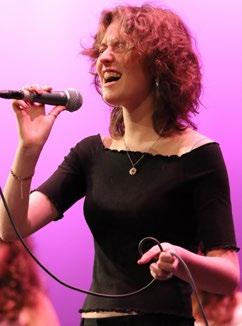
to supporting students as they learn how to improvise over harmonic frameworks through the development of accompaniments using multitrack recording. This approach scaffolds for learning to improvise over complex structures through an incremental process of conceptual and creative development.
Interactive Jazz Performances through Reverse Engineering
Dan Barrett
Communication and interaction between the musicians bring great energy to jazz, and are among the things we enjoy most from a great performance. This session explores detailed listening to great recordings in order to pull out some key principles to work on with our students. We’ll tackle some things that each instrument in the jazz ensemble can do, in addition to their default roles, to bring a creative and collaborative approach to the music.
Motivic Development and Communication in Jazz Improvisation: Taking your students’ improv to the next level
Ryan Blotnick, Daniel Fischer-Lockhead, & Aaron Henry
Jazz Improvisation has been focused on scales, arpeggios, and licks for a long time. In this session, we’ll
focus less on notes and scales and learn methods and techniques to help students work with the material they already know and get them to communicate, playing cohesive, developable ideas to take their improvisation to the next level.
Reading Session: Original Music from NYC Downbeat Magazing Rising Star Trombonist Alan Ferber for Jazz Big Band and Nonet
Alan Ferber
This Jazz reading session with be led by one of the world’s finest trombonists, Alan Ferber. Join us as we read through some of Alan’s great music for big band and nonet, which can be found on his website at https://www.alanferber.com/
How to Drive the Bus: Top 10 Tips and Tricks for the Most Important Chair in the Big Band: Your Drummer!
Bill Leather
The drummer’s role in a Big Band is crucial to the success of your ensemble. This session is designed to give you concepts to help your drummers make an immediate impact on the ability of your ensemble to swing more like the pros!
Developing YOUR Sound, Tone, and Embouchere on Jazz saxophone and woodwinds
Aaron Henry
Help your students learn to develop their best tone and OWN it as their voice. Focus will be on vocalization of notes, airflow, embouchure, reed strength, mouthpiece options, lip/ muscle flexibility, and imitation of jazz saxophonists.
some of the best jazz musicians from USM - Chase Whelan, Chris Caliskan, Jorge Allen, Saxophones - Ry Johnson, Guitar - Nicholas Freeman, Drums - Matthew Harding, BassJosie Lawrence, Voice. Compositions to be chosen from originals, works by Chris Potter, Stevie Wonder, Art Blakey, Bill Evans, and more.
Alan Ferber
Rhythm is arguably the most important element in jazz music, though it all too often takes a back seat to melody and harmony during the process of learning how to improvise. This clinic, geared toward all instrumentalists and vocalists, will focus on ways to develop your internal sense of time and rhythm. We will focus specifically on the triplet, exploring different ways to strengthen your rhythmic independence and generate ideas that give your improvising a stronger and more compelling rhythmic “dance.” This clinic encourages participation from everyone, and a few instrumentalists/vocalists will be invited up to the stage for individual feedback.

We often look outside of ourselves for the solutions and answers to the challenges we face. Dr. Matthew Arau reminds us that despite the hurdles, we can make a significant difference by tapping into the power within ourselves and our team-members. Through choosing our personal upbeat and being intentional with how we teach and lead, we can create a positive, inclusive culture by design and elevate the level of learning, performance, joy, belonging, empowerment, and motivation.
USM Chamber Jazz Combo
Director: Aaron Henry
A performance by the USM Chamber Jazz Combo led by Aaron Henry from the Fall ‘23 semester, featuring

In this fun and engaging session, Dr. Matthew Arau shares how choosing our personal upbeat makes a significant difference in the quality of our lives, our music-making, our attitude, and in the lives of those we impact. Remove the lid on your potential and learn how to make the most of every day while lifting up and inspiring those you lead.
“Compass Rose” cont. from page 15
but they aren’t specific. It’s in the specifics where your philosophy will both help you and defend you. What specific pieces will you program for your students to learn this year? What specific percentage of your students’ grades will be based on their performance, versus their attendance, versus their attitude? What specific festivals will your groups attend, what specific performances will they do? Is it worth it to have a show choir, a marching band, an a capella group, a string quartet, a percussion ensemble or some other specific group? You will be called upon to justify every decision you make, and any decision can potentially be questioned by an irate parent or an administrator caught in

Bill Bell
Attendees are encouraged to bring in works for various string orchestra levels that the group can play through. Please bring your string instrument! A list of pieces along with their level will be shared at the end of the reading session.
Rob Lorimer
ithout a philosophy, you will just be blowing in the wind, pushed in -
tion somebody is yelling the loudest. With a philosophy, an anchor. Which is why every viewed musicing job asked sharetion. Trust me, spend the time on this to develop one—it will be well worth your effort! n
This session will help with basic string repair including changing strings, bridge adjustments, chin rest adjustments, peg adjustments, etc. You do not need to be a string player to attend!
Anna Clement
This session will focus on how to set up your string students for success. Step by step exploration of foundational teaching methods that are proven for the successful, confident string playing.
Anna Clement
A strong foundation for string players is crucial, but how to do you help develop your beginning student orchestras to sound…Beautiful? And how do you foster and continue to develop tone production in large and small classes? This session will continue to discuss methods and ideas for developing a strong tone in multi level groups. From classroom rehearsal strategies to repertoire; this session explores it all.

Bill Lacey
From its simple beginnings of school exchange concerts and away games, student travel has evolved into an industry designed to bring students, teachers and family members together, “in contact” with educational, cultural, and significant landscapes and events apart from their own. In our Roundtable, we’ll focus on 4-5 specific points-of-interest in timeline format: Venue/Location selection; contract and itinerary agreements; payment programs and financial obligations; cancellation policies and travel insurance. As air travel is sometimes on the table for high school groups, we’ll focus on TSA, safety and required documentation. There has never been a better time to incorporate travel into your program, as recruitment, reward or adjudication/performance.